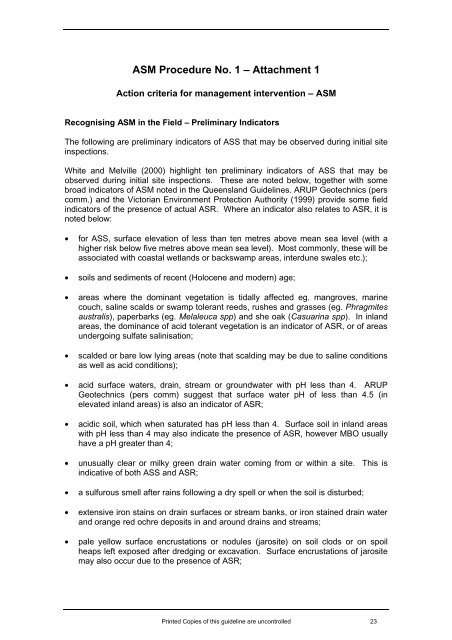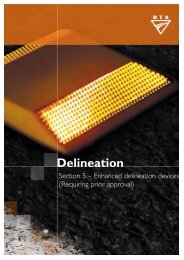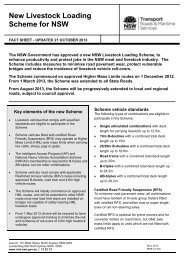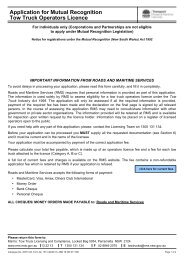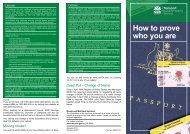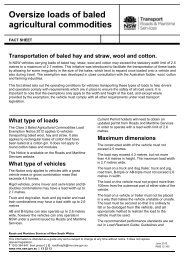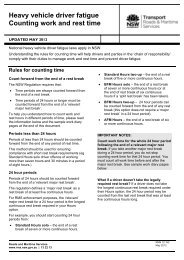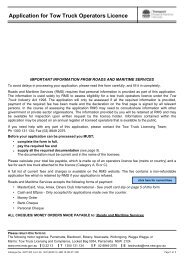Guideline for the Management of Acid Aulphate Materials - RTA
Guideline for the Management of Acid Aulphate Materials - RTA
Guideline for the Management of Acid Aulphate Materials - RTA
You also want an ePaper? Increase the reach of your titles
YUMPU automatically turns print PDFs into web optimized ePapers that Google loves.
ASM Procedure No. 1 – Attachment 1<br />
Action criteria <strong>for</strong> management intervention – ASM<br />
Recognising ASM in <strong>the</strong> Field – Preliminary Indicators<br />
The following are preliminary indicators <strong>of</strong> ASS that may be observed during initial site<br />
inspections.<br />
White and Melville (2000) highlight ten preliminary indicators <strong>of</strong> ASS that may be<br />
observed during initial site inspections. These are noted below, toge<strong>the</strong>r with some<br />
broad indicators <strong>of</strong> ASM noted in <strong>the</strong> Queensland <strong>Guideline</strong>s. ARUP Geotechnics (pers<br />
comm.) and <strong>the</strong> Victorian Environment Protection Authority (1999) provide some field<br />
indicators <strong>of</strong> <strong>the</strong> presence <strong>of</strong> actual ASR. Where an indicator also relates to ASR, it is<br />
noted below:<br />
• <strong>for</strong> ASS, surface elevation <strong>of</strong> less than ten metres above mean sea level (with a<br />
higher risk below five metres above mean sea level). Most commonly, <strong>the</strong>se will be<br />
associated with coastal wetlands or backswamp areas, interdune swales etc.);<br />
• soils and sediments <strong>of</strong> recent (Holocene and modern) age;<br />
• areas where <strong>the</strong> dominant vegetation is tidally affected eg. mangroves, marine<br />
couch, saline scalds or swamp tolerant reeds, rushes and grasses (eg. Phragmites<br />
australis), paperbarks (eg. Melaleuca spp) and she oak (Casuarina spp). In inland<br />
areas, <strong>the</strong> dominance <strong>of</strong> acid tolerant vegetation is an indicator <strong>of</strong> ASR, or <strong>of</strong> areas<br />
undergoing sulfate salinisation;<br />
• scalded or bare low lying areas (note that scalding may be due to saline conditions<br />
as well as acid conditions);<br />
• acid surface waters, drain, stream or groundwater with pH less than 4. ARUP<br />
Geotechnics (pers comm) suggest that surface water pH <strong>of</strong> less than 4.5 (in<br />
elevated inland areas) is also an indicator <strong>of</strong> ASR;<br />
• acidic soil, which when saturated has pH less than 4. Surface soil in inland areas<br />
with pH less than 4 may also indicate <strong>the</strong> presence <strong>of</strong> ASR, however MBO usually<br />
have a pH greater than 4;<br />
• unusually clear or milky green drain water coming from or within a site. This is<br />
indicative <strong>of</strong> both ASS and ASR;<br />
• a sulfurous smell after rains following a dry spell or when <strong>the</strong> soil is disturbed;<br />
• extensive iron stains on drain surfaces or stream banks, or iron stained drain water<br />
and orange red ochre deposits in and around drains and streams;<br />
• pale yellow surface encrustations or nodules (jarosite) on soil clods or on spoil<br />
heaps left exposed after dredging or excavation. Surface encrustations <strong>of</strong> jarosite<br />
may also occur due to <strong>the</strong> presence <strong>of</strong> ASR;<br />
Printed Copies <strong>of</strong> this guideline are uncontrolled 23


